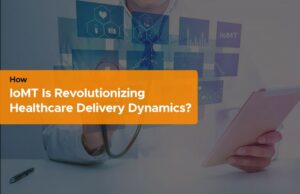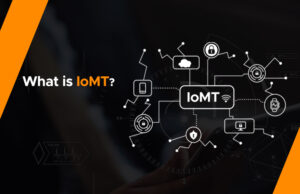ThusThe sudden Coronavirus (COVID-19) outbreak has raised the alert level for the entire healthcare system. Technology advancements, changing patient expectations, and the need for more effective and efficient healthcare delivery drive a great revolution in the healthcare sector. The healthcare industry is changing in many ways due to this revolution, including patient care, engagement, research, and data analytics.
The situation has been greatly improved by the Internet of Medical Things (IoMT), and COVID-19 has inspired scientists to create a new, “smart” healthcare system that focuses on early diagnosis, spreading-prevention, education, and treatment as well as making it easier to adapt to the new normal.
More on IoMT
The term “Internet of Medical Things” (IoMT) describes medical software and hardware that can connect to the Internet. It is frequently referred to as IoT in the healthcare industry because it is a subset of Internet of Things (IoT).
IoT devices tend to be more user-friendly and convenient, with a stronger consumer focus. Smart TVs, lighting apps, voice assistants, and a wide variety of other connected, intelligent devices are examples of IoT devices. Healthcare is a major consideration in the design of IoMT devices and applications, including:
- Infusion pumps and smart thermometers
- Devices for remote patient monitoring
- Systems for individual emergency response (PERS)
- glucose metres and heart rate sensors
- ingestible cameras and sensors
- MRI equipment
Research predicts that the global IoMT market will be worth USD 187.60 billion by 2028, growing at a 29.5% compound annual growth rate (CAGR). The rapid advancement of medical technology has led to the emergence of essential devices for screening, diagnosing, treating, returning patients to normal lives, and monitoring their health indicators to prevent disease. Data gathered by medical technology devices can be transferred to cloud platforms through a wireless network for later analysis and storage. Enabling machine communication can raise the standard of care throughout the entire healthcare delivery system.
How IoMT is Revolutionizing Healthcare
The healthcare industry is undergoing a remarkable transformation driven by technological advancements, and at the forefront of this revolution is the Internet of Medical Things (IoMT). This part of the article explores how IoMT is revolutionizing healthcare delivery dynamics, enhancing patient care, improving operational efficiency, and transforming the overall healthcare experience.
Real-Time Monitoring and Remote Care
IoMT enables real-time patient vital signs monitoring, allowing healthcare providers to track and assess patients’ health status remotely. Wearable devices and sensors collect data on heart rate, blood pressure, glucose levels, and other relevant metrics, which can be transmitted to healthcare professionals in real time. This capability revolutionizes remote care, enabling proactive interventions, early detection of health issues, and improved management of chronic conditions.
Enhanced Patient Engagement and Self-Management
IoMT empowers patients to participate in their healthcare journey actively. Access to personal health data through mobile apps and patient portals allows individuals to monitor their health, track progress, and engage in self-management. This increased involvement leads to better treatment adherence, lifestyle modifications, and overall health outcomes.
Streamlined Workflows and Operational Efficiency
IoMT streamlines healthcare workflows and enhances operational efficiency. Connected medical devices automate data collection and transfer, reducing manual errors and saving valuable time for healthcare providers. Integrating IoMT with electronic health records (EHRs) allows for seamless data integration, facilitating real-time access to patient information, improving care coordination, and enabling data-driven decision-making.
Early Intervention and Preventive Care
IoMT is crucial in shifting healthcare from a reactive to a proactive model. By continuously monitoring patients’ health metrics, IoMT facilitates the early detection of anomalies and enables timely intervention. For instance, remote monitoring of heart rate patterns can alert healthcare providers to potential cardiac events, allowing for prompt medical attention and preventive care strategies.
Data-Driven Insights and Predictive Analytics
The vast amount of health data IoMT devices generate presents an opportunity for data-driven insights and predictive analytics. Advanced analytics algorithms can analyze large datasets to identify patterns, trends, and predictive models. These insights can inform population health management strategies, disease surveillance, and personalized treatment plans, leading to more targeted interventions and improved patient outcomes.
Improved Patient Safety and Medication Management
IoMT helps enhance patient safety and medication management. Smart medication dispensers, for example, can remind patients to take their medication, track adherence, and notify healthcare providers in case of non-compliance. IoMT-enabled medication reconciliation systems can reduce medication errors and adverse drug interactions, improving patient safety and reducing healthcare costs.
Challenges and Considerations of IoMT
The interconnected network of medical equipment, software programs, and health systems that gather, process, and transmit health data is known as the Internet of Medical Things (IoMT). While IoMT offers numerous benefits in healthcare, it also presents certain challenges and considerations. Addressing these challenges and concerns is essential for successfully implementing and utilizing IoMT in healthcare. By doing so, IoMT has the potential to revolutionize patient care, enhance clinical decision-making, and improve overall healthcare outcomes.
Data Security and Privacy
IoMT generates a massive amount of sensitive health data, including patient information, vital signs, and medical records. Ensuring robust security measures to protect this data from unauthorized access, breaches, and cyber-attacks is crucial. Organizations must implement strong encryption, authentication protocols, and data anonymization techniques to maintain patient privacy.
Interoperability
IoMT involves a diverse range of medical devices, sensors, and systems that need to communicate and exchange data seamlessly. However, achieving interoperability among different technologies can be challenging due to data formats, protocols, and standards variations. Developing and adopting common interoperability standards are necessary to enable smooth data exchange and collaboration.
Reliability and Accuracy
Medical devices connected through IoMT must provide accurate and reliable data for informed decision-making. Any glitches, malfunctions, or inaccuracies in the devices or the network infrastructure can compromise patient safety and treatment outcomes. Ensuring rigorous testing, calibration, and quality control processes is essential to maintain reliability.
Regulatory Compliance
The use of IoMT in healthcare is subject to various regulatory frameworks, such as data protection laws (e.g., GDPR), medical device regulations, and health information security standards (e.g., HIPAA). Organizations must navigate and comply with these regulations to safeguard patient rights, maintain data integrity, and avoid legal consequences.
Scalability and Infrastructure
IoMT requires a robust and scalable infrastructure capable of handling the increasing volume of data generated by connected devices. Healthcare organizations must invest in advanced data storage, processing capabilities, and network bandwidth to support the growing demands of IoMT applications.
Ethical Considerations
As IoMT collects vast amounts of personal health data, ethical considerations arise regarding this information’s ownership, consent, and use. Patient’s autonomy, support, and control over their data should be respected, and healthcare providers must maintain transparency in data collection and usage practices.
Integration with Existing Systems
Integrating IoMT solutions with existing healthcare systems and workflows can be complex. Legacy systems and infrastructure may not be readily compatible with new devices and technologies, requiring careful planning and coordination to ensure seamless integration without disrupting existing operations.
Training and Education
Healthcare professionals must be trained and educated to use and interpret the data IoMT devices provide effectively. They should understand the limitations and potential risks associated with these technologies and the appropriate actions to take based on the data received.
Cost and Return on Investment
Implementing IoMT solutions can involve significant upfront costs, including device acquisition, network infrastructure, and security measures. Therefore, organizations must carefully evaluate the return on investment, considering improved patient outcomes, operational efficiencies, and cost savings in the long run.
Patient Acceptance and Adoption
Patient acceptance and adoption of IoMT solutions can be a challenge. Some patients may have concerns about privacy, data security, or the reliability of these technologies. Healthcare providers must effectively communicate the benefits and address patient concerns to encourage acceptance and adoption of IoMT.
Final Words
IoMT is ushering in a new era of healthcare delivery that prioritizes patient-centric care, fosters efficiency, and embraces the power of data-driven decision-making. Remote patient monitoring, telemedicine, streamlined operations, personalized care, and improved medication adherence are just a few ways IoMT revolutionizes healthcare.
As the IoMT ecosystem evolves, we must navigate the challenges and seize opportunities. Thus, by doing so, we can ensure a future where technology enables accessible, efficient, and patient-focused healthcare for all.
By leveraging IoMT’s capabilities, underserved communities can receive timely diagnoses, preventive care, and expert consultations, leveling the playing field for healthcare delivery.







